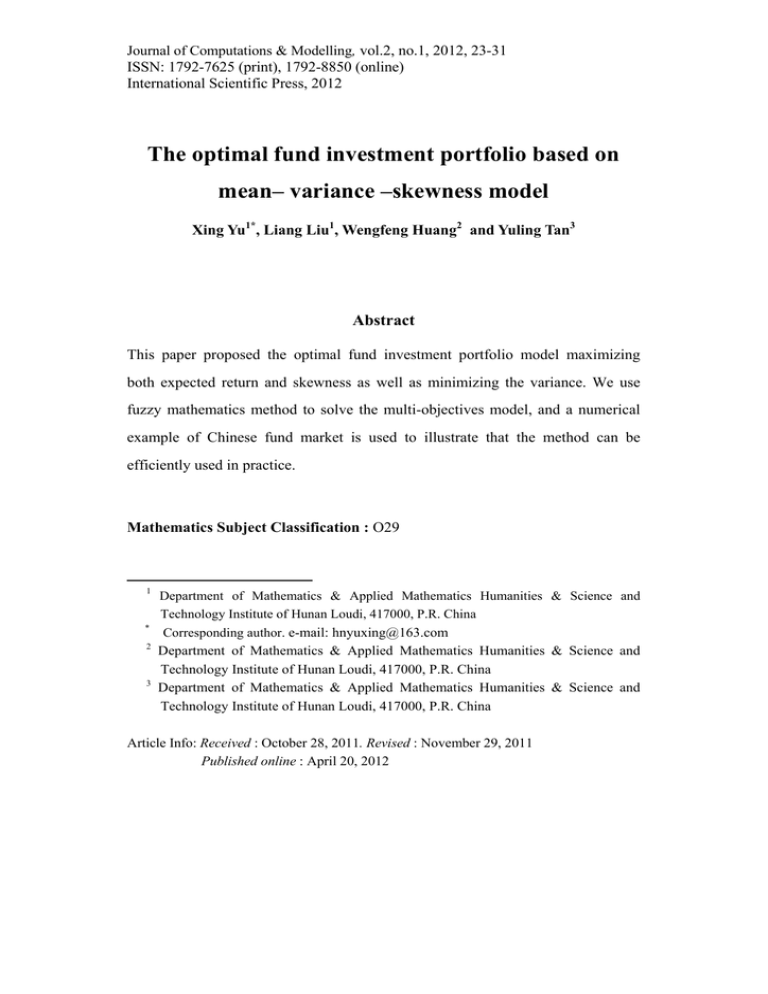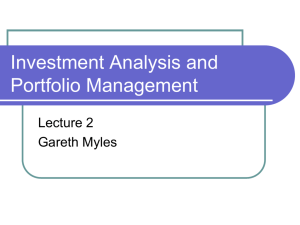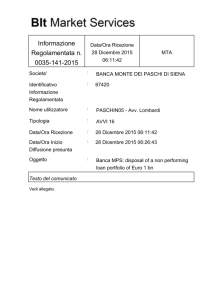The optimal fund investment portfolio based on mean– variance –skewness model Abstract
advertisement

Journal of Computations & Modelling, vol.2, no.1, 2012, 23-31 ISSN: 1792-7625 (print), 1792-8850 (online) International Scientific Press, 2012 The optimal fund investment portfolio based on mean– variance –skewness model Xing Yu1*, Liang Liu1, Wengfeng Huang2 and Yuling Tan3 Abstract This paper proposed the optimal fund investment portfolio model maximizing both expected return and skewness as well as minimizing the variance. We use fuzzy mathematics method to solve the multi-objectives model, and a numerical example of Chinese fund market is used to illustrate that the method can be efficiently used in practice. Mathematics Subject Classification : O29 1 Department of Mathematics & Applied Mathematics Humanities & Science and Technology Institute of Hunan Loudi, 417000, P.R. China * Corresponding author. e-mail: hnyuxing@163.com Department of Mathematics & Applied Mathematics Humanities & Science and Technology Institute of Hunan Loudi, 417000, P.R. China Department of Mathematics & Applied Mathematics Humanities & Science and Technology Institute of Hunan Loudi, 417000, P.R. China 2 3 Article Info: Received : October 28, 2011. Revised : November 29, 2011 Published online : April 20, 2012 24 The optimal fund investment portfolio … Keywords: The optimal portfolio, mean–variance–skewness model, Multi-objectives programming, Fuzzy mathematics method 1 Introduction Portfolio optimization has come a long way from Markowitz [1] seminal work which introduces return/variance risk management framework, which is called M-V model. There is a lot of literature has improved the M-V model. Samuelson (1970) shows that when the investment decision is restricted to a finite time interval, the use of mean-variance approximation becomes inadequate, and the higher moments become more relevant to portfolio choice [2]. Harvey and Siddique [3, 4] introduce an asset pricing model that incorporates conditional skewness, and show that an investor may be willing to accept a negative expected return in the presence of high positive skewness [3, 4]. Cascon, Keating and Shadwick [5] argue that point estimates of mean and variance of an assumed sampling distribution are insufficient summaries of the available information of future returns. Instead they advocate the use of a summary function, which they call “Omega”, that represents all the relevant information contained within the observed data. One problem with the mean–variance–skewness trade-off model for portfolio selection is that it is not easy to find a trade-off between the three objectives because this is a nonsmooth multi-objective optimization problem. Leung et al. [6] provided a goal programming algorithm to solve a mean–variance–skewness model with the aid of the general Minkovski distance. Diverging from previous studies, Wang and Xia [7] transformed the mean–variance–skewness model into a parametric linear programming problem by X. Yu, L. Liu, W. Huang and Y. Tan 25 maximizing the skewness under given levels of mean and variance. Our paper is organized as follows. In the second section we present the notation used in the paper, and the initial computations for skewness. In the third section, the optimal portfolio model is proposed. Fuzzy mathematics algorithm technique is given in section four. In Section five, empirical study is performed. 2 Notation [8] 2.1. Portfolio inputs The portfolio comprises N assets. The portfolio weights are denoted w [ w1 , w2 wN ] . The time series of returns on these assets are represented as ri where i 1, 2,..., N . The inputs to the model comprise the vector of mean returns on these N assets, denoted [ 1 , 2 N ] . The covariance matrix of these assets is denoted ij i , j 1N . Both these central moments are calculated in the usual way. Likewise, we define the non-central skewness (S) of returns as: S Sijk i , j , k 1N . These tensors are easy to compute from the data. We note that Sijk E ri rj rk , Sijk can also be written in a slightly different form: Siii 1 N 3 1 ri ri , Siij N i 1 N 2 1 ri ri rj rj , Sijj N i 1 N These comprise the raw moments from the data. ri ri rj rj i 1 N 2 26 The optimal fund investment portfolio … 2.2. Portfolio moments Given portfolio weights w , the mean and variance of the portfolio are obtained via the usual calculation: m1 p w , m2 2 p ww The non-central third moment of the portfolio is: n n n m3 wi w j wk Sijk i 1 j 1 k 1 And the skewness of the portfolio is: S p ( w) 3 1 m3 3m2 m1 2m13 p ( w) 3 Portfolio model with higher moments We construct a investment portfolio maximizing expected return and skewness of return and minimizing the variance of return simultaneously. That is: max m1 w min m2 ww P 1 max S p w 3 m3 3m2 m1 2m13 w p w is the proportion invested in various assets when the best trade-off is found. It is noted that, in this study, negative w represents a short sale. X. Yu, L. Liu, W. Huang and Y. Tan 27 4 Solution of multi-objective linear programming model with fuzzy mathematics Because the objective functions of multi-objective programming are more than one, it is difficult to reach a certain point for all of the objective functions, to whose maximum, that is the optimal solution is usually does not exist. Therefore, it needs to make a compromise plan making each target function as large as possible in a specific problem. And fuzzy mathematical programming method can deal with the problem, which will turn the multi-target model to a single one. Step1: to solve every single maximum objective Z i , i 1, 2,..., r under the constrains 1 2 , n Z i* max Z i Z i cij , Ax b, x 0 , i 1, 2,..., r j 1 To choose di , d i 0 as the corresponding fuzzy telescopic factor for each target Z i , i 1, 2,..., r . Generally, fuzzy telescopic factors are chosen according to various sub-targets importance, that is the more important goal, the smaller the flexible index should be. In this paper, let di Z i* Z i , where Z i min Z i , which is solved following the same method as Z i* . Step 2: constructing fuzzy objective M i of target Z i , whose membership function is: 28 The optimal fund investment portfolio … n M i x gi cij x j j 1 0, n 1 1 Z i* cij x j , j 1 di 1, r n c x j 1 ij j Z i* di n Z i* d i cij x j Z i* j 1 n Z i* cij x j j 1 Let M x M i x , the multi-objective problem P2 is transformed as: i 1 max Z n 1 1 Z * c x , i 1, 2,..., r ij j di i j 1 (P3) n a x b , k 1, 2,..., m kj j k j 1 x1 , x2 xn 0 0, This is a single objective linear programming solved with LINGO easily. 5 Numeral study 5.1 Data In order to analyze the optimal fund investment portfolio based on mean–variance–skewness model, we use a model with only 2 assets in the fund portfolio, thereby keeping ideas simple. The annualized mean return vector and covariance matrix of returns are computed and are as follows: 0.06760987 , 0.034191 0.058884101 0.000464043 0.000464043 0.0003643663 X. Yu, L. Liu, W. Huang and Y. Tan 29 We need to represent the co-skewness matrix in two slices since it is of dimension 2 2 2 . These are as follows: 0.004202153 0.001709551 0.001709551 1.378430e 04 Sij1 , Sij 2 0.001709551 0.000137843 0.000137843 7.875703e 05 According to the known data and the formula, the former three moments are: m1 p w 0.06760987 w1 0.034191w2 m2 2 p ww (.58884e-1*w1 +.46404e-3*w 2 )*w1 +(.46404e-3*w1 +.36437e-3*w 2 )*w 2 m3 w13 *0.0004202153 w12 *w 2 *0.001709551 w12 *w 2 *0.001709551 w1*w 2 2 *0.000137843 w12 *w 2 *0.001709551 w1*w 2 2 *0.000137843 w1*w 2 2 *1.3784e-04 w 23 *7.875703e-05 The optimal fund portfolio model is the same as ( P) . 5.2 Model We solve the sub-model looking for the minimum and maximum value of every moment; max m1 0.06760987 w1 0.034191w2 s.t w1 w2 1 , P1 1 w1 1; 1 w1 1 min m1 0.06760987 w1 0.034191w2 s.t w1 w2 1 P 1 w1 1; 1 w1 1 ' 1 It is easily solved by LINGO, whose result is max m1 m1 0.06760987 , min m1 m1 0.034191 . The same method to solve P 2 , P 2 . 30 The optimal fund investment portfolio … max m2 (.58884e-1*w1 +.46404e-3*w 2 )*w1 +(.46404e-3*w1 +.36437e-3*w 2 )*w 2 s.t w1 w2 1 P 2 1 w1 1; 1 w1 1 min m2 (.58884e-1*w1 +.46404e-3*w 2 )*w1 +(.46404e-3*w1 +.36437e-3*w 2 )*w 2 s.t w1 w2 1 P 2 1 w1 1; 1 w1 1 The optimal value are max m2 m2 0.058884 , min m2 m2 0.00036437 . For simple, we directly give max S p w S 17.5195 , min S p w S -0.7631919 Finally, we propose the optimal model as follow: max= ; m1 -0.033419 0.034191; -m 2 -0.055524 0.00036437; (m3 -3m 2 m1 +2m12 )/(m 21.5 )-18.28269 -0.7631919 ; m1 =0.06760987w1 +0.034191w 2 ; m 2 =(.58884e-1w1 +.46404e-3w 2 )w1 +(.46404e-3w1 +.36437e-3w 2 )w 2 ; m3 =w13 0.0004202153+w12 w 2 0.001709551+w12 w 2 0.001709551+w1w 2 2 0.000137843 +w12 w 2 0.001709551+w1w 2 2 0.000137843+w1w 2 21.3784e-04+w 23 *7.875703e-05; w1 +w 2 =1; -1 w1 1;-1 w 2 1; where is the belief degree. We get that w1 0.332, w2 0.668 . 5.3 Conclusion In this numeral example, we propose a optimal portfolio model considering the former three moment of the portfolio return, which modify the general mean-variance model. By solving the model, we get the optimal invest weights are w1 0.332, w2 0.668 . X. Yu, L. Liu, W. Huang and Y. Tan 31 Acknowledgment. This research was partially supported by Hunan University research study and innovative pilot projects. References [1] H.M. Markowitz, Portfolio selection, Journal of Finance, 7, (1952), 77-91. [2] P. Samuelson, The fundamental approximation of theorem of portfolio analysis in terms of means, variances and higher moments, Review of Economic Studies, 37, (1970), 537-542. [3] C.R. Harvey and A. Siddique, Conditional Skewness in Asset Pricing Tests, Journal of Finance, 55, (2000), 1263-1295. [4] C.R. Harvey and A. Siddique, Time-Varying Conditional Skewness and the Market Risk Premium, Research in Banking and Finance, 1, (2000), 27-60. [5] A. Cascon, C. Keating, et al., The Omega Function, London, UK, The Finance Development Centre, 2003. [6] M.T. Leung, H. Daouk and A.S. Chen, Using investment portfolio return to combine forecasts: a multiobjective approach, European Journal of Operational Research, 134, (2001), 84-102. [7] S.Y. Wang and Y.S. Xia, Portfolio selection and asset pricing, Berlin, Springer, 2002. [8] Rishabh Bhandari, Sanjiv R. Das, Options on portfolios with higher-order moments, Finance Research Letters, 6, (2009), 122-129.


